|
Operation Musketoon
- Glomfjord, Norway.
15/21 September 1942
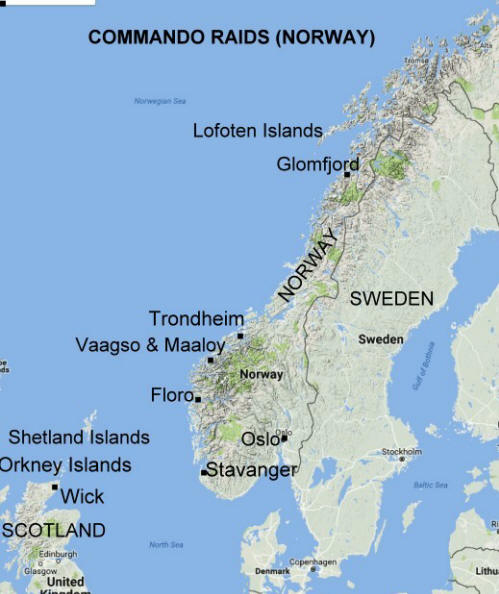
Background
German control of Norway's wealth of natural resources posed a
considerable threat to the Allied cause, in this case, aluminium, which
was vital to the enemy's aircraft production.
Operation Musketoon was a
daring, small scale Commando raid on an
electricity generating station at Glomfjord in German occupied Norway, just
north of the Arctic Circle. The station provided electricity for a
nearby aluminium plant, without which the manufacture of the metal would come to a halt.
[Map courtesy
of Google Map Data 2017].
The raiding party comprised 2 Officers, 8 Commandos from No 2 Commando and 2 Norwegian corporals working
for the Special Operations Executive (SOE). They were transported by submarine
to a remote, neighbouring Fjord from where they negotiated a difficult high level, overland route to
approach their target from the rear. Although they destroyed the plant, a
high price was paid.
Plans & Preparations
The Free
French submarine, Junon, had a silhouette similar to some German U boats,
a useful attribute when working close to enemy held coastlines. She slipped her
moorings in the Orkney Islands at 11.40 am on September 11, 1942. For a few
hours, she was escorted by submarines HMS Sturgeon, Tigress and Thunderbolt.
On board were the crew, 12 Commandos, two rubber dinghies lashed to her casing
and a variety of guns, ammunition, explosives and supplies.
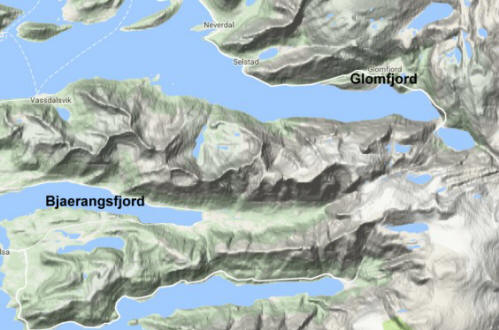 The
small raiding party was led by Captain Graeme D Black, MC, from Ontario, Canada
with Captain Joseph B J Houghton, MC, 2nd in command. There were 8 other ranks
from No 2 Commando - Rifleman Cyril Abram, Private Eric Curtis, Corporal John
Fairclough, L/Sergeant William Chudley, Private Reginald Makeham, C S M
Miller Smith, Sergeant Richard O'Brien, Private Fred Trigg and two Norwegian
corporals working for the Special Operations Executive (SOE), Corporal Erling M
Djupdraet and Corporal Sverre Granlund - in all a party of 12. The
small raiding party was led by Captain Graeme D Black, MC, from Ontario, Canada
with Captain Joseph B J Houghton, MC, 2nd in command. There were 8 other ranks
from No 2 Commando - Rifleman Cyril Abram, Private Eric Curtis, Corporal John
Fairclough, L/Sergeant William Chudley, Private Reginald Makeham, C S M
Miller Smith, Sergeant Richard O'Brien, Private Fred Trigg and two Norwegian
corporals working for the Special Operations Executive (SOE), Corporal Erling M
Djupdraet and Corporal Sverre Granlund - in all a party of 12.
[Map courtesy
of Google Map Data 2017].
The power
station was located at the head of Glomfjord. Black anticipated that the Germans
would be well prepared for a frontal attack from the west, since access from
other directions was very difficult, especially with the onset of the Arctic
winter. To achieve the element of surprise, he decided to disembark from the
submarine in Bjaerangsfjord, immediately south of Glomfjord, which had been the
original choice.
Commander
Querville, of the Junon, agreed to this change of plan despite having no
information on currents, depths and conditions on the bottom of Bjaerangsfjord.
As they passed up the fjord, the skipper of a local fishing boat spotted their
periscope just ahead and keeping pace with him. At the time, the Commandos were
taking in the beauty of the scenery and were completely unaware of the fishing
boat behind them. When the navigator later took a 360 degree sweep, the fishing
boat was spotted and the sub dived. Fortunately the sighting did not compromise
the raid.
Action
 On
arrival at the head of Bjaerangsfjord on the afternoon of the15th, they settled
gently on the bottom. They surfaced again at 9.15 pm when the dinghies were made
ready and they launched into the darkness of the night, passing close by the
hamlet of Bjaerangsjoen and several houses on the shore. They landed safely,
deflated the dinghies and hid them under moss and stones. However, they had been
spotted by an elderly lady around 1 am on the 16th but her "vision" was,
fortunately, attributed by her neighbours to an over-active imagination! On
arrival at the head of Bjaerangsfjord on the afternoon of the15th, they settled
gently on the bottom. They surfaced again at 9.15 pm when the dinghies were made
ready and they launched into the darkness of the night, passing close by the
hamlet of Bjaerangsjoen and several houses on the shore. They landed safely,
deflated the dinghies and hid them under moss and stones. However, they had been
spotted by an elderly lady around 1 am on the 16th but her "vision" was,
fortunately, attributed by her neighbours to an over-active imagination!
[(Courtesy
of Michel Guyot) © 2013 Michel Guyot all rights reserved].
The men
were well rested and fed by the time they set out over a grassy plain between
the fjord and the mountains to the north. At a safe distance from the hamlet,
they grabbed a few hours of fitful sleep, had breakfast of hot soup and tea and
struck out once more. They took cover when some cattle and a herdsman passed
close by, otherwise the trek to the mountains was uneventful. On reaching the
foot of the Black Glacier, Houghton and Granlund reconnoitred the route ahead,
while the others rested. When they returned two hours later, they started the
ascent. The walking was easy on the lower slopes but soon gave way to more
difficult terrain. At one point, they traversed a near vertical rock face, with
hand and foot holds down to one inch in places but thanks to the expertise of
Sergeant O'Brien, it was undertaken successfully. There were some anxious
moments en route but they gained the summit in clear blue skies and warm
sunshine providing them with stunning panoramic views down to the sea.
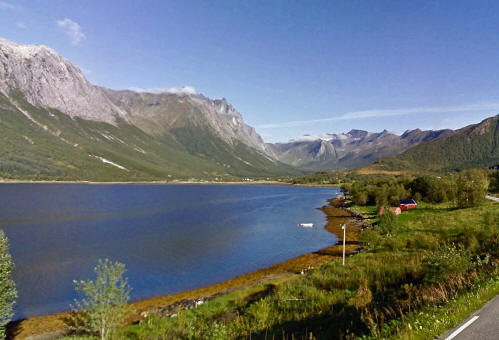 As
the Commandos relaxed, they were blissfully unaware that a German topographical
party, led by Lieutenant Wilhelm Dehne, was active in the area at the time. He
spotted some figures close to the Lake above Glomfjord but they were too
indistinct for identification. As
the Commandos relaxed, they were blissfully unaware that a German topographical
party, led by Lieutenant Wilhelm Dehne, was active in the area at the time. He
spotted some figures close to the Lake above Glomfjord but they were too
indistinct for identification.
Later in the day he discovered some discarded "Players" cigarette packets and
other scraps of paper at the impromptu camp. Fortunately, Dehne's pet dog, which
he had on the outward trek, had returned to Glomfjord on a coastal ferry from
Bjaerangsfjord. But for this piece of good fortune, the Commandos might have
been found.
[Head of
Bjaerangsfjord. Copyright Google Earth 2017].
In the
event, Dehne's route back to Glomfjord took him well away from where the
Commandos were laid up. By dusk they were on a narrow trail with a sheer drop to
a lake. Later, the two Norwegians found a shelter, which overlooked the power
station at the head of Glomfjord. It was the night of the 17/18th.
They
remained in hiding the next day, while they considered the lay of the land and
finalised plans for both the attack and withdrawal. At about 8 pm on the
18/19th, they set off towards the power station. As they neared the bottom of
the hill, they heard the chugging of a small craft and indistinct singing. Since
surprise was vital, they retreated uphill but had not yet gained the high
ground, when dawn broke. They were in a relatively exposed position but heavy
rain and their decision not to move, ensured they remained undetected. They
cursed the leaky "watertight" British sleeping bags and the atrocious Norwegian
weather ... and they had run out of food. Black decided to attack that
night - the 19/20th September.
As they
descended once more, O'Brien, Chudley and Curtis split from the main group to
lay charges on the two high pressure pipelines. They selected a place where the
pipelines pointed directly at the station. With a little difficulty, the 808
plastic explosive collars were secured in place with 30 minute pencil fuses
attached but not activated. The explosives were designed to blow a one meter gap
in the 7 foot diameter pipes. It was just before midnight, when the two men
settled down to wait for the signal to activate the fuses.
About the
same time, the remaining 9 men arrived at the rear of the power station, where
they gained entrance to the generator hall. 7 of them initially took cover
behind some packing cases and 2 took up position as sentries outside. There was
no one in the generator hall and after some German guards left the control room,
only one Norwegian engineer was visible. There was a relaxed atmosphere and it
was clear that the presence of the Commandos had gone unnoticed.
Their
immediate objective was to secure the area and evacuate the Norwegian workers.
In the chaotic minutes that followed, the whereabouts of the Norwegian workers
was established, including those asleep in rooms at the top of the building.
They were rounded up and ordered to remove themselves urgently from the area
using a tunnel over a mile in length. It was the only land route between the
station and nearby villages further down Glomfjord. A smoke bomb was placed in
the tunnel to delay German reinforcements. One German guard was shot by Granlund
as he dozed and another escaped through the tunnel to raise the alarm. Meantime,
the
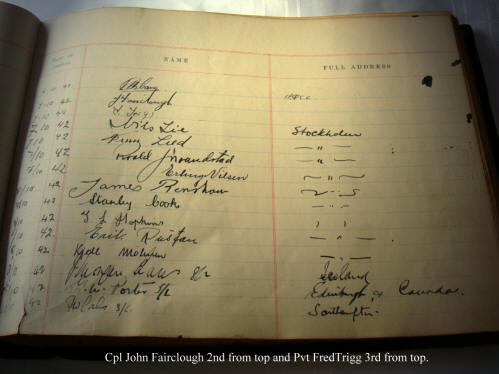 explosives were laid on the three turbines and three generators and the 10
minute fuses set. The alarm was raised and, about this time, flashes were seen
coming from the power station. The Germans were well and truly alerted. explosives were laid on the three turbines and three generators and the 10
minute fuses set. The alarm was raised and, about this time, flashes were seen
coming from the power station. The Germans were well and truly alerted.
[Photo; Cpt Fairclough &
Pvt Trigg's signatures in RAF
Leuchars Visitors' Book on their return to the UK after the raid. Provided by
Trevor Baker].
Withdrawal
The sound
of the explosions in the turbine hall was the signal O'Brien and his men, higher
up the mountain, had been waiting for. The fuses were activated, which gave the
party 30 minutes to gain higher ground before millions of gallons of water came
thundering down the hillside. All 12 met up and proceeded up the mountain in
darkness. Meantime, German reinforcements had arrived but were unwilling to use
the tunnel for fear of an explosion. Boats were commandeered and more and more
soldiers were transported past the tunnel obstruction.
Norwegian
corporal, Granlund, moved well ahead of the others and was first to arrive at a
mountain hut known as Fykandalen. It was occupied by two Norwegian conveyor belt
operators and a young female Norwegian cook. He asked for the location of a
nearby suspension bridge that led to a "staircase" of steps up the mountain and
a hastily drawn map was prepared. Granlund failed to find the bridge and by the
time he returned to the hut, he found Houghton and Djupdraet groping around in
the dark. They had returned to the hut, unaware that two Germans had, in the
meantime, entered it. The Norwegian occupants had denied seeing British soldiers
and the Germans visibly relaxed, to the point of removing rounds from one of
their guns.
It
transpired, that when Houghton and Djupdraet returned to the hut, a rather
confused fight ensued, resulting in one German dead, one wounded and Djupdraet
injured in the stomach by a bayonet. After administering morphia to Djupdraet,
the rest of the men split into groups of 2 or 3 and made their way up the
mountain. By this time, the main body of pursuing German troops were nearing the
area of the
 hut. Trigg, O'Brien, Granlund and Fairclough were on Navervann
Mountain to the north and Black, Houghton, Smith, Chudley, Curtis, Abram and
Makeham were to the south negotiating the steep slopes of Middago Mountain. At
this point, Houghton was wounded in the right forearm, as the enemy closed in
and it became clear there was no escape for the latter group and all 7 were
captured. hut. Trigg, O'Brien, Granlund and Fairclough were on Navervann
Mountain to the north and Black, Houghton, Smith, Chudley, Curtis, Abram and
Makeham were to the south negotiating the steep slopes of Middago Mountain. At
this point, Houghton was wounded in the right forearm, as the enemy closed in
and it became clear there was no escape for the latter group and all 7 were
captured.
[Photo; Sgt Richard
O'Brian's signature in RAF
Leuchars Visitors' Book on his return to the UK after the raid. Provided by
Trevor Baker].
As
they were led down the mountain, they could see, with great satisfaction, the
massive extent of the devastation they had caused. The aluminium plant did not
reopen during the remainder of the war. Djupdraet died in hospital three days
after the raid. Trigg and Fairclough were repatriated by plane from Stockholm to
RAF Leuchars in Scotland on the 7th of October, followed by O'Brian on the 22nd
and finally Granlund. They later met Mountbatten in London, followed by MI5
debriefing. Without the assistance of many ordinary but courageous
citizens of Norway and Sweden, it is almost certain that all would have been
captured.
The
seven captured men were taken by boat, train and truck to Colditz Castle.
Despite the best efforts of the Germans to isolate them from the regular
prisoners, there was sufficient contact to confirm their presence there. There
was some confusion amongst the Germans about what should happen to the Commandos
but, ominously, they were transported to Berlin, arriving at Camp
Sachsenhausen in the afternoon of October 22nd.
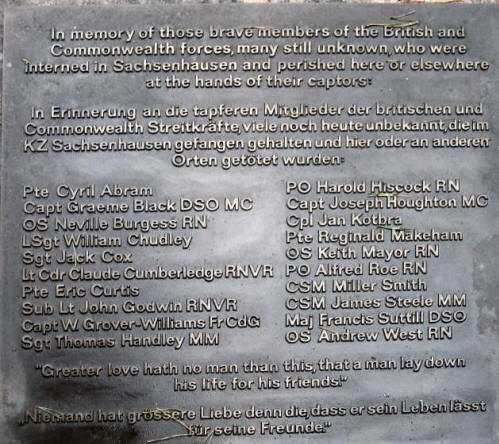 They were detained overnight in what was effectively a prison within a prison.
At about 11pm, the names of the Commandos were posted up with an "SD"
designation, signifying that they were to be executed. Just before dawn on the
23rd, they were taken out under SD command. Each was killed by a single shot in
the back of the neck and their bodies cremated. None of the prisoners or regular
guards in the camp knew what had taken place. They were detained overnight in what was effectively a prison within a prison.
At about 11pm, the names of the Commandos were posted up with an "SD"
designation, signifying that they were to be executed. Just before dawn on the
23rd, they were taken out under SD command. Each was killed by a single shot in
the back of the neck and their bodies cremated. None of the prisoners or regular
guards in the camp knew what had taken place.
[Photo of memorial plaque at Sachsenhausen showing the names of the seven -
Abram, Black, Chudley, Curtis, Houghton, Makeham and Smith... courtesy of Pamela
Hannah].
These Commandos were the first to fall victim to
Hitler's
Commando Order
of 18 Oct 1942. On the 15th of November 1945, Capt Black was posthumously
awarded the Distinguished Service Order, effective from 22/10/42.
Of the four
survivors, Granlund was lost in Feb 1943 with all hands, when Norwegian
submarine Uredd sank off the Norwegian coast. Fred Trigg was killed in
Italy. Only O'Brien and Fairclough survived the war.
The hopes
of relatives and friends were raised when the Germans let it be known that the
Commandos had escaped. This disinformation was a cruel attempt to cover-up the
grotesque truth. Hopes and expectations for many back home remained high and it
was only after the war that the real fate of the men became known.
Outcome
The raid
was an outstanding success but, even before the return of the four survivors,
Mountbatten had decided on a fresh approach for winter operations in such
hostile weather and terrain. No doubt the debriefing of the survivors confirmed
that view. The outcome was the establishment, in the Shetland Islands, of a
special Troop of No 12 Commando under Capt FW Fynn. Officially called
North Force, the designation Fynn Force was used for "hardening training" for
the Commandos to obscure the real purpose.
Further Reading
There are around 300 books listed on
our 'Combined Operations Books' page. They, or any
other books you know about, can be purchased on-line from the
Advanced Book Exchange (ABE). Their search banner link, on our 'Books' page, checks the shelves of
thousands of book shops world-wide. Just type in, or copy and paste the
title of your choice, or use the 'keyword' box for book suggestions.
There's no obligation to buy, no registration and no passwords.
Musketoon - Commando Raid on Glomfjord 1942 by Stephen Schofield. Pub by
Jonathon Cape 1964.
....and
other Commando raids.
Commandos and Rangers of World War 2 by James D. Ladd. Pub in 1978 by
MacDonald & Jane's. ISBN 0 356 08432 9
Commandos 1940 - 1946 by Charles Messenger. Pub by William Kimber, London
1985. ISBN 0 7183 0553 1
The
Watery Maze by Bernard Fergusson published 1961 by Collins.
Please let us know
if you have any information or book recommendations to add to this page.
Correspondence
Glomfjord in 2013
".....
our heroes are still very much honoured by the locals to this date. We will
remember them." We're very grateful to Ashley
Barnett for his comments and photos. After 73 years, it's heart warming to know
that those who took part in Operation Musketoon are still remembered and
respected for what they did by the people living in the Glomfjord area. Ashley
visited the area in 2013 as part of a group organised by Military History Tours.

The small raiding party came ashore from the submarine Junon along
this stretch of
Bjaerangsfjord. It was around 10 pm in the evening of September 15 1942.
This view looks towards the sea end of the fjord.

The raiding party's clandestine approach to the power station followed the
same route taken by today's pipelines.

The interior
of power plant with its original machinery. The hall was extended post war.
There is an annual commemorative walk along the route the raiding party
took, albeit in the reverse direction.

The
power station exterior.
Throughout our stay in Glomjford we were treated like VIPs by the local
people we met. Their understanding and appreciation of the raid was self
evident and the process of education and remembrance continues to this day
in local schools.
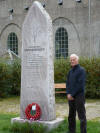
This
photo shows
a relative of rifleman Cyril Abram, one of the fallen Commandos beside a
memorial near the power station.
We were
presented with a fragment of the original pipeline which had been blown
apart during the raid. It was a surreal and humbling experience.
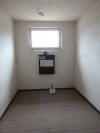
After Glomfjord we visited Sachenhausen in Germany to see the cell which
held the captured Commandos prior to their executions. The relative of
Cyril Abram continued his
journey of remembrance with a
visit to Colditz Castle where the Commandos were held prior to
their transfer to Sachenhausen.
Captain
Graeme D Black M.C.
No. 2
COMMANDO was formed by volunteers from 41 different regiments of the British
Army and one Canadian soldier from Dresden, Ontario.
Lieutenant Black was my first training officer when I arrived as a seventeen
year old, accepted for Commando service. I remember him as a very respected
leader and also as a man who had already won the Military Cross. Behind the
ribbon of the M.C. he had four bullet holes in his left shoulder from the
Vaagso,
Norway raid.
After
No. 2 Commando had been decimated in the
St. Nazaire raid,
Lieutenant Black was promoted to Captain and became my Troop Commander. He was
held in high esteem and we were sorry when he departed for another operation in
Norway.
The
operation with our Canadian, Captain Black, in command, left Scotland by
submarine in September, 1942. The raiding force arrived in Glomfjord, Norway and
landed its ten members from No. 2 Commando, who then destroyed the power plant
objective. It was a perfect, textbook example of efficiency and courage. The
massive devastation caused by this tiny force resulted in an important aluminium
plant not re-opening during the remainder of the war.
The
withdrawal of the raiding force was to be made by trying to walk across the
mountains to Sweden. By the time the withdrawal got underway the force was
without food and just about everything else. They were all captured and taken to
Germany. Captain Black and six others were executed in Berlin on October 23,
1942. Our boys were the first to fall victim to Hitlerís "Commando Execution
Order" of October 18, 1942.
During the
course of World War II, the British Army Commandos earned thirty-eight battle
honours and many other awards, including eight Victoria Crosses. It was a record
which prompted the Founder of the Commandos, Winston Churchill, to pay the
following tribute to the Commandos:
"We may
feel that nothing of which we have any knowledge or record has ever been done by
mortal men, which surpasses their feats of arms. Truly we may say of them, when
shall their glory fade?"
I like to
think that maybe Sir Winston had Captain Black in mind.
Bob Bishop,
(No 2 Commando) Royal British Legion (St. James Branch), Royal Canadian Legion
(Branch 60).
Acknowledgments

Musketoon -
Commando Raid on Glomfjord 1942 by Stephen
Schofield. Pub by Jonathon Cape 1964, was the main source of information in
preparing this page.
|














